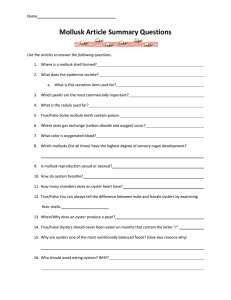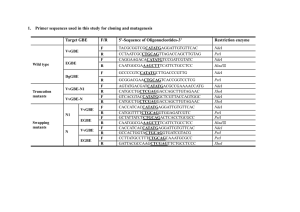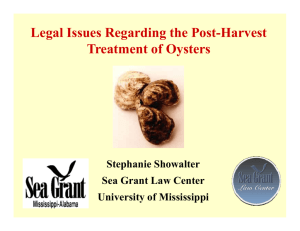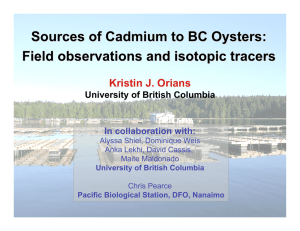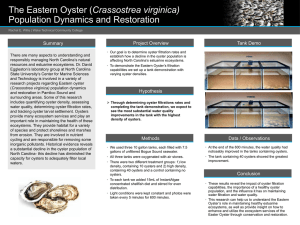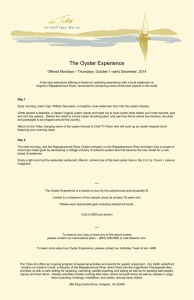Monte Carlo analysis of the product handling and high-pressure
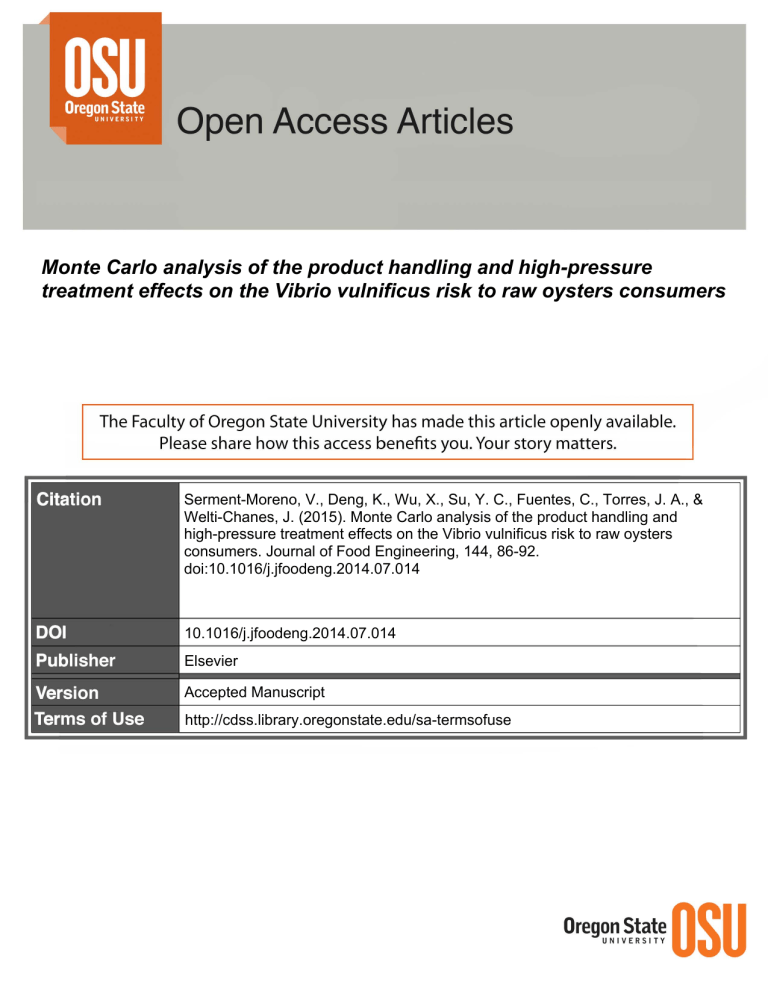
Monte Carlo analysis of the product handling and high-pressure treatment effects on the Vibrio vulnificus risk to raw oysters consumers
Serment-Moreno, V., Deng, K., Wu, X., Su, Y. C., Fuentes, C., Torres, J. A., &
Welti-Chanes, J. (2015). Monte Carlo analysis of the product handling and high-pressure treatment effects on the Vibrio vulnificus risk to raw oysters consumers. Journal of Food Engineering, 144, 86-92. doi:10.1016/j.jfoodeng.2014.07.014
10.1016/j.jfoodeng.2014.07.014
Elsevier
Accepted Manuscript http://cdss.library.oregonstate.edu/sa-termsofuse
7
8
9
10
11
12
13
14
4
5
6
1
2
3
15
16
17
18
19
20
21
22
23
Monte Carlo analysis of the product handling and high-pressure treatment effects on the Vibrio vulnificus risk to raw oysters consumers
Vinicio Serment-Moreno a,b
, Kai Deng b
, Xulei Wu b
, Yi-Cheng Su c
, Claudio
Fuentes d
, J. Antonio Torres b
and Jorge Welti-Chanes a
(a) Centro de Biotecnología FEMSA, Escuela de Biotecnología y Alimentos,
Tecnológico de Monterrey, Av. Eugenio Garza Sada 2501 Sur, Col. Tecnológico,
64849, Monterrey, NL, México; (b) Food Process Engineering Group,
Department of Food Science & Technology, Oregon State University, 100
Wiegand Hall, Corvallis, OR 97331, USA; (c) Seafood Research and Education
Center, Oregon State University, 2001 Marine Dr., Astoria, Oregon 97103, USA; and, (d) Statistics Department, Oregon State University, 54 Kidder Hall, Corvallis,
OR 97331, USA
Corresponding Author: José Antonio Torres, Food Process Engineering Group,
Department of Food Science & Technology, Oregon State University, 100
Wiegand Hall, Corvallis, OR 97331, USA, +1-541-737-4757, Fax +1-541-737-
1877, Email: J_Antonio.Torres@OregonState.edu
Short version of title: Vibrio vulnificus risk in untreated and high pressure processed raw oysters
24 ABSTRACT
25 A Monte Carlo procedure considering the variability in oyster handling from
26 harvest to raw consumption estimated reductions in the number of Vibrio
27 vulnificus induced septicemia cases achieved by high-pressure processing
28 (HPP). The calculations yielded pathogen load distributions in raw oysters from
29 harvest to consumption. In the warm season, 2-6 min treatments at 250 MPa and
30 1°C would lower the predicted number of septicemia cases associated with raw
31 oyster consumption from 4,932 to less than four per 100 million consumption
32 events (95% confidence). This study highlighted that HPP conditions should be
33 selected according to the seasonal pathogen load and environment temperature.
34 Finally, the procedure emphasized that the variability in the V. vulnificus
35 population at harvest, before and after HPP treatments, reflecting in part the
36 microbiological quantification methods used, significantly affected the estimated
37 number of septicemia cases. Therefore, improving microbiological quantification
38 should provide better predictions of the number of septicemia cases.
39
40 Keywords: oyster, high pressure processing, Vibrio vulnificus , Monte Carlo
41 analysis, beta-Poisson dose response models, seafood poisoning risk
42
43 1. Introduction
44 Oysters and other bivalve mollusks are filter feeders and thus concentrate
45
microbial pathogens and other environmental contaminants (He et al., 2002).
46 Among pathogens found in oysters, Vibrio vulnificus poses a severe health threat
47 due to its ability to cross the intestinal barrier reaching the blood stream and
48
causing primary septicemia (up to 55% fatality rate) (Chiang and Chuang, 2003).
49 V. vulnificus proliferates in warm seawater (>20°C) with moderate salinity (5-
50 25%), and thus consumption of raw oysters is particularly unsafe during summer
51
days (Motes et al., 1998). The Interstate Shellfish Sanitation Conference (ISSC)
52 proposed the application of shellfish post-harvest treatments reaching a 3.52-log
53 reduction in V. vulnificus counts with an endpoint of non-detectable counts at the
54
level of <30 cfu/g (ISSC, 2011). To reach this safety standard, high pressure
55 processing (HPP) at 200-300 MPa is likely the best alternative amidst oyster
56 pasteurization treatments. HPP is a well-established processing technology
57
(Mújica-Paz et al., 2011) able to reduce pathogen levels (Cook, 2003; Kural and
58
Chen, 2008) while shucking oysters (Torres and Velazquez, 2005) and yielding
59
products with high consumer acceptance (Cruz et al., 2011).
60 The efficacy of HPP treatments eliminating V. vulnificus in oysters harvested
61 from different seasons can be determined by microbial risk assessment (MRA).
62 MRA is an essential tool in the management of foodborne pathogens risks and
63 the development of international food trade standards. MRAs, particularly
64 quantitative MRAs, are resource-intensive tasks in which the reported incidence
65 frequency of food-borne disease outbreaks (FBDOs), the pathogen load in the
66 foods involved, and the food amount consumed per serving are used to generate
67
a pathogen dose-illness response model for a given population group (Holcomb
68
et al., 1999; Teunis et al., 2008). The Beta-Poisson model (Eq. 1), a recurring
69 mathematical expression for pathogen dose-illness response predictions,
70 assumes that the food microbial load is known and can be described by a
71 Poisson distribution. Furthermore, a single pathogen, with a probability described
72
73
74 by a Beta distribution of surviving the patient defense mechanisms, is deemed sufficient to cause the illness. The parameter
α
determines the shape of the dose-response curve, whereas
β
regulates the shift along the vertical axis
75
(Holcomb et al., 1999; Strachan et al., 2005; Teunis and Haavelar, 2000).
P ill
( d ;
α
;
β )
=
1
−
(
1
+ d /
β ) − α
(1)
76
77 Dose-response model development difficulties include a general lack of studies
78 using human volunteers, and when available, these studies are restricted to
79
healthy populations (Coleman and Marks, 1999; Foegeding, 1997) violating
80 essential statistical principles. Moreover, most published dose-response models
81 assume that all pathogen strains are equally virulent as in the case of FBDOs
82 involving V. vulnificus . Additionally, bioassays performed to determine strain
83 virulence rely primary on animal models, and thus their results may not be valid
84 for humans. Furthermore, although animal studies indicate that most strains are
85 virulent, not all appear to be so in humans. Consequently, the seasonal and
86 regional distribution of virulent V. vulnificus
strains remains unknown (DePaola et
87
88 The first and most important step when assessing processing technologies is to
89 select operating conditions for specific food applications reducing known
90
91 microbial risks by a specific number of decimal reductions, or by lowering the pathogen survival probability to a specified level (e.g., 1 spore in 10
9
containers).
92 Another frequently overlooked aspect is that kinetic studies rarely discern
93 between sub-lethal and lethal effects of microbial inactivation treatments. In
94 addition, effects on sensory or nutritional quality caused by the entire food
95 microflora are ignored when a single microorganism is being targeted. More
96 recently, regulatory agencies have begun to require evidence that these process
97 objectives are met with a high probability typically set at a 95% confidence
98 interval ( 95CI
) considering all relevant variability factors (Fernandez et al., 1999;
99
Rieu et al., 2007; Smout et al., 2000). Monte Carlo based calculations have been
100 used to meet this new regulatory requirement for different food products and
101
processes (Chotyakul et al., 2011a; Chotyakul et al., 2011b; Salgado et al.,
102
2011). In this work, the impact factors and their variability involved in the handling
103 of raw oysters from harvest to consumption were analyzed with a Monte Carlo
104 procedure to estimate the V. vulnificus load with 95CI at consumption. The risk of
105 consuming these untreated and HPP-treated raw oysters was then determined
106 by a dose-response analysis.
107
108 2. Materials and Methods
109 2.1. Parameters in the chain from harvest to oyster consumption
110 The following paragraphs describe the data sources and their variability for the
111 handling factors considered in this study and the calculations required by the
112 Monte Carlo model predicting the V. vulnificus risk when consuming untreated
113 and HPP-treated raw oysters.
114 2.1.1 Vibrio vulnificus counts at harvest
115
The information collected by Motes et al. (1998) for the 1994-95 harvest from
116 multiple sites in the northern México Gulf coast was pooled to describe the initial
117 V. vulnificus load in raw oysters used in this study (log N harvest
; Table 1). Since
118 the load of this pathogen depends mostly on seawater temperature, microbial
119 counts were grouped into warm (summer, Jun-Sep), transitional (spring, Apr-
120 May; fall, Oct-Nov), and cold (winter, Dec-Mar) seasons.
121 INSERT TABLE 1
122
123 2.1.2 Oyster transportation from harvest site to processing facilities
124 The time during which oysters remain unrefrigerated after harvest ( t holding
; h)
125 varies widely depending on the fishery boat operation. Reports by the World
126 Health Organization (WHO), and the U.S. Center for Food Safety and Applied
127 Nutrition (CFSAN), show that a Beta-PERT distribution can describe this
128 transportation time. The following minimum ( min ), maximum ( max ), and most
129 likely ( mlk ) t holding
values were used in this study: (a) spring, summer, and fall
130 seasons: min = 3 h, max = 10 h, mlk = 7 h; and, (b) winter season: min = 2 h,
131 max = 11 h, mlk
= 8 h (FDA and CFSAN, 2005; WHO and FAO, 2005).
132 The growth of V. vulnificus during transportation was estimated by the three
133
134
135
136
phase linear model (Eq. 2, Buchanan et al., 1997; WHO and FAO, 2005) where
μ max
is the maximum growth rate (cfu/h), and A is the highest V. vulnificus load found in oysters sold to consumers and defined as 10
6
cfu/g oyster
by WHO and
FAO (2005). Moreover, the maximum growth rate (
μ max
; Eq. 3) was assumed
137 directly proportional ( m = 0.011 cfu/h·°C) to the difference between the
138 transportation ambient temperature ( T air
; Table 2) and a minimum growth
139 temperature ( T
0
= 13°C) (Kaspar and Tamplin, 1993; WHO and FAO, 2005).
140 These authors assume that when the transportation temperature is lower than
141 the minimum growth temperature (13°C), V. vulnificus cells enter a viable but
142 nonculturable (VBNC) state in which there is neither microbial growth nor death.
143 Therefore, Eq. 3 selects the maximum value between zero and the temperature
144 difference term ( T air
– T
0
) through the function “max” to distinguish the growth
145 response below and above 13°C. log N transporta tion
= min
[ log N harvest
+ m max
⋅ t holding
, A
]
(2) m max
= max
[
0 , m
⋅
(
T air
−
T
0
) ]
(3)
146 INSERT TABLE 2
147
148 2.1.3 Oyster post-harvest processing and storage
149 In this study, harvested oysters for raw consumption were considered to be
150
stored under the typical 5-10°C commercial temperature conditions (Cook et al.,
151
2002; FDA and CFSAN, 2005; Su and Liu, 2007), or subjected to HPP
152 treatments and then stored at the same conditions. Under these storage
153 conditions, several reports indicate that V. vulnificus counts will decrease at a
154
rate of 0.041 log units per day (Cook et al., 2002; WHO and FAO, 2005). The
155 time before raw consumption ( t refrigeration
; days) under 5-10°C was described by
156 the following Beta-PERT distribution parameters determined in a national survey
157 within the United States: (a) min = 1 day; (b) max = 21 days; (c) mlk = 7 days
158
(Cook et al., 2002; WHO and FAO, 2005). Thus, the load of
V. vulnificus at retail
159 ( N
0
; cfu/g oyster
) was calculated as in Eq. (4): log N
0
= log N transporta tion
−
0 .
041
⋅ t refrigerat ion
(4)
160
161 Table 3 shows HPP treatments at 250 MPa and 1°C approaching the pressure
162
163
processing conditions (293 MPa, 8°C, 2 min) for which Ma and Su (2011)
achieved ≥ 3.52 decimal reductions of
V. parahaemolyticus as recommended for
164
shellfish post-harvest processing (ISSC, 2011) . As in the case of untreated
165 oysters, the rate of reduction in V. vulnificus counts for HPP treated oysters
166 ( N
HPP
; cfu/g oyster
) during cold storage was calculated by considering the same
167 rate of 0.041 log units per day when stored under the typical 5-10°C commercial
168
temperature conditions (Eq. 6) (Cook et al., 2002; WHO and FAO, 2005).
log N
HPP
= log N transporta tion
−
SV
HPP
(5) log N
0
= log N
HPP
−
0 .
041
⋅ t refrigerat ion
(6)
169 INSERT TABLE 3
170 2.1.4 Oyster consumption and risk assessment
171 WHO correlated records of septicemia incidences caused by V. vulnificus (no
172 specific strain) from 1995 to 2001 with estimates of V. vulnificus counts at
173 consumption to obtain Beta-Poisson model parameters (Table 4) describing the
174 relationship between probability ( P ill
) of developing septicemia and V. vulnificus
175
load (Anonymous, 2005). In this study, the pathogen dose was calculated by
176 multiplying the V. vulnificus load in untreated and HPP-treated oysters after cold
177 storage ( N
0
; cfu/g oyster
; Eq. 4), the meat amount per oyster (Table 4; Anonymous,
178
2005), and the number of oysters consumed per serving obtained from a
179
published survey given in the “Consumption vector” column of Table 4 (Degner
180
and Petrone, 1994). The latter may be interpreted as in the following example:
181 according to the survey, 61 persons claimed to have consumed six oysters per
182 serving. Therefore, the number 6 appeared 61 times in the 306-element vector
183 describing the number of oysters per serving.
184 INSERT TABLE 4
185
186 2.2. Monte Carlo estimations
187 The mean (
μ
REP
) and standard deviation (
σ
REP
) values reported for parameters
188 following normal or log-normal distributions: V. vulnificus counts at harvest,
189 ambient temperature during transportation from harvest site to processing plant,
190
191 meat weight per oyster, Beta-Poisson model parameters, and HPP decimal reductions; were used with Microsoft Excel
TM
to generate random data vectors.
192
The Excel add-in developed by Hayes and Jacobs (2011) was used for variables
193 estimated through the Beta-PERT distribution: transportation time from harvest
194 site to processing facilities, and storage refrigeration time. The number of oysters
195 consumed per serving was the only variable not following a parametric statistical
196 distribution. Therefore, the number of oysters consumed per serving used in this
197 study was generated based on the frequency of each oyster consumption
198
number as reported in the published survey with 306 participants (Degner and
199
Petrone, 1994). The number of oysters consumed per serving was selected
200 randomly from this vector.
201
202 2.2.1 Determination of the random probability distribution data vectors size
203 Randomized vectors with n = 10, 50, 100, 200, 500 and 1,000 elements were
204 generated to assess the effect of the vector size on the Monte Carlo estimation
205 method as implemented in this study (Figure 1). These calculations were
206 performed with the spring season data and for SV
HPP
= 6.3±1.5, since these
207 conditions represented the input with the highest variability. The 95% confidence
208 interval ( 95CI ) of the logarithm of illness probability (log P ill
) after ingesting
209 untreated and HPP-treated oysters were calculated 1,000 times for each random
210 vector size. An ANOVA test was performed to detect first significant differences
211 and then mean comparisons of 95CI values were performed with a Tukey test
212 (95% confidence level) to determine which vector size was adequate to deliver
213 consistent estimations of log P ill
. Once the optimal vector size was determined,
214 the same calculations were repeated for warm (summer), transitional (fall/spring),
215 and cold (winter) seasons to ensure that log P ill
determinations remained
216 consistent.
217 INSERT FIGURE 1
218
219 2.2.2 Effect of seawater temperature on dose response analysis
220 Warm (summer), transitional (fall/spring), and cold (winter) seasons calculations
221 with the optimized random vector size were implemented to assess the effect of
222 seawater temperature on the risk of consuming untreated and HPP-treated
223 oysters, and to evaluate the V. vulnificus load for each oyster handling step from
224 harvest to consumption.
225
226 2.2.3 Assessing the impact of reductions in the variability in parameters subject
227 to raw oyster producer control
228 The reported standard deviation of several factors in oyster-handling steps can
229 be reduced by changes in commercial oyster production practices and
230 improvements in data collection (e.g., microbial enumeration methods).
231 Reductions in the variability of some factors without a change in their mean
232
233 values may lower significantly the estimated probability of septicemia infections.
Half-reductions in the standard deviation (0.5
σ
REP
) of the following parameters
234 were considered in this study: (a) microbial counts at harvest (Log N harvest
); (b)
235 ambient temperature during transportation from harvesting site to processing
236 facilities ( T air
); (c) transportation time ( t holding
); (d) storage time at 5-10°C
237 ( t refrigeration
); and, (e) V.
vulnificus decimal reductions achieved by high pressure
238 processing ( SV
HPP
).
239
240 3. Results
241 3.1 Size of the random probability distribution data vectors
242
243
Logarithmic illness probability (Log P ill
, 95% confidence) values for untreated oysters stabilized quickly ( n
≥ 50; Figure 2a) whereas values for HPP-treated
244 oysters varied widely when n < 200 (Figure 2b). Moreover, a mean comparison
245 analysis indicated no significant difference of Log P ill
for n = 100-1,000 for both
246 untreated and HPP-treated oysters ( p value
> 0.05). The variation coefficient ( VC )
247 remained below 5.1% for all cases when the vector size was at least n = 100. For
248 n = 1,000, the VC reached values below 0.5 and 1.5% for untreated and HPP-
249 treated oysters, respectively (Figure 2b). Furthermore, simulations with n = 1,000
250
251 for all other seasons resulted in similar consistent results for 95CI Log P ill calculations ( VC
≈ 1.5%; data not shown). Consequently, random data vectors
252 with 1,000 elements were sufficient for the Monte Carlo analysis used in this
253 study.
254 INSERT FIGURE 2
255
256 3.2 HPP treatments at 250 MPa and 1°C
257 At 95% confidence, all treatments were predicted to meet the post-harvest
258 processing objective, although the 2 min process yielded significantly higher
259
260 decimal reductions ( SV
HPP
≥ 4.56; p value
< 0.05) than the 4 and 6 min treatments
( SV
HPP
≥ 4.29 and 3.88, respectively). This apparent contradiction with the
261
262
263 reported decimal reduction mean values (see Table 3) reflects the lower variability of the least severe treatment (
σ
REP
= 0.2) as compared to the more severe processes (
σ
REP
= 0.7 and 1.5). The large experimental data dispersion
264 reported for the 4 and 6 min treatments may reflect experimental artifacts, or
265 enumeration method limitations, as revealed by the Monte Carlo analysis here
266 presented. Moreover, the Monte Carlo analysis showed that the predictions of
267 the mildest HPP treatment analyzed in this study (250 MPa, 1°C, 2 min) is clearly
268 sufficient to pasteurize oysters in accordance to the ISSC recommendation.
269 INSERT FIGURE 3
270
271 3.3 Dose exposure for untreated and HPP-treated oysters in different seasons
272 Seawater temperature affects significantly the pathogen loads in oysters reported
273 for each season ( p value
> 0.05) as reflected in the estimated V. vulnificus dose of
274 untreated (horizontal axis) and HPP-treated oysters (vertical axis) shown in
275 Figure 4. The pathogen level range (90% confidence) were highest for summer
276 (log d
0
= 5.02 to 7.35 cfu/serving; Figure 4a) and considerably lower for the
277 winter season (log d
0
= 0.80 to 2.79 cfu/serving; Figure 4b). V. vulnificus
278 exposure doses for the spring and fall seasons (data not shown) displayed the
279 broadest range, covering nearly 4 log units in the horizontal axis (log d
0
= 2.68 to
280 6.59 and 2.23 to 6.22 cfu/serving, respectively). The calculated arithmetic means
281 for spring and fall were intermediate values (log d
0
= 4.65 and 4.29, respectively)
282 between those generated for the summer (log d
0
= 6.19) and winter (log d
0
=
283 1.75) seasons. The data variability difference between the predicted HPP
284 treatments was observed clearly in the range of log d
HPP
(90% confidence) value
285 for the 2 min (2.2 to 2.5 log units) and the 6 min (5.5 to 5.6 log units) processes
286 (Figure 4).
287 INSERT FIGURE 4
288
289 3.4 Dose response modeling for untreated and HPP-treated oysters harvested
290 in different seasons
291 The estimated illness probability values did not approach log P ill
= 0 ( P ill
= 1)
292
293
294 even when the exposure dose reached extremely high values (Figure 5). The illness probability approached a maximum value log P ill
≈ -4.31 for the summer season at dose levels approaching 10
7
cfu/serving. The reason for this data
295 behavior is that the parameter values for the Beta Poisson model used in this
296 study have limitations because they were determined from public health records
297 and thus do not include extremely low dose values rarely causing an FBDO, nor
298 extremely high doses theoretically expected to affect 100% of the population.
299 Still, the analysis did confirm that the summer consumption of untreated oysters
300 should be avoided since they cause an unacceptably high public health risk,
301 estimated at 4,932 septicemia cases for every 100 million consumption events
302 ( 95CI = log P ill
= -4.307, Table 5).
303 INSERT FIGURE 5
304 The estimated probability of acquiring septicemia through oyster consumption
305 reduced significantly ( p value
< 0.05) for all HPP treatments analyzed in Table 5.
306 The 95% confidence intervals of septicemia cases during summer would be
307 substantially decreased to just 2-4 cases for every 100 million consumption
308 events (log P ill
= -7.34 to -7.62), whereas no cases would be expected to occur in
309 the winter (log P ill
= -11.73 to -12.26). These estimated values suggest that
310 intervention technologies reducing raw oyster consumption risk such as HPP
311 treatments should be applied with different intensity throughout the year, i.e., the
312 same low consumer exposure dose can be achieved throughout the year but
313 operational costs would be reduced by eliminating over processing when the
314 pathogen load in the untreated oyster is low. The definition by regulatory
315 agencies of a minimum consumer risk is a necessity since complete absence of
316 a pathogen in oysters is not possible. Low risks of foodborne illness are present
317 even after severe food processing conditions.
318 INSERT TABLE 5
319
320 3.5 Effect of the standard deviation reduction in the oyster handling conditions
321 on estimated V. vulnificus counts
322 At the 90% confidence interval, a slight but significant bacterial growth
(≈ 0.2-1.2
323 log units; p value
>0.05) was estimated to occur during transportation from oyster
324 harvesting sites to the process facility in all seasons except in the winter (Table
325
326
6). This modest pathogen growth is followed by a decrease in V. vulnificus counts during refrigerated storage
(≈ 0.2-0.4 log units; Table 6).
327 INSERT TABLE 6
328
329 Temperature and storage time during boat fishery and retail operations are
330 susceptible to important fluctuations as shown in Section 2.1. Additionally,
331 environmental factors at the oyster harvest site and the microbial quantification
332 methodologies can induce variability affecting the predicted V. vulnificus counts.
333 Therefore, the effect of the statistical variability in the handling steps from harvest
334 to consumption on the V. vulnificus load distribution in raw oysters was
335 determined to identify steps in which variability could be controlled to lower P ill
336 estimations. To investigate the effect of the handling steps variability, Log P ill
337
338 distributions were generated with the same mean but with standard deviation reduced by 50% (0.5
σ
REP
) for the oyster handling parameters listed in section
339
340
341
2.2.3. The range of the estimated Log P ill
values narrowed significantly when lowering the reported
σ
REP
values for log N harvest
, SV
HPP
, or by simultaneously decreasing the
σ
REP
for all variables ( p value
< 0.05). Whereas the latter yields no
342 specific recommendations on how to improve oyster, these results suggest the
343 need to identify those factors responsible for high Log N harvest
values, and to
344 repeat inactivation experiments with large standard deviations in SV values. .
345
346 4. Conclusions
347 This study showed that a Monte Carlo analysis facilitates the inclusion of the
348 statistical variability of the multiple factors affecting the selection of the operating
349 conditions for processing technologies reducing microbial risks such as HPP
350 treatments of raw oysters. The analysis showed also that consumers and
351 processors would benefit from food safety regulations enforced by requiring
352 consumption risk reductions achieved by intervention designs considering
353 statistical variability. This approach is a superior regulatory standard alternative
354 to specifying a number of decimal reductions or an endpoint microbial load value.
355 Consumption of HPP-treated raw oysters should be encouraged as the analysis
356 here presented predicted an important reduction in the number of septicemia
357 cases caused by Vibrio vulnificus . For example, the HPP conditions evaluated in
358 this study reduced the risk in the summer to fewer than 4 cases per 100 million
359
360 raw oyster consumption events. The predicted HPP treatment effect met the shellfish pasteurization standard ( SV
HPP
≥ 3.52) by delivering with 95%
361 confidence 3.88-4.56 decimal reductions in V. vulnificus counts. Moreover, the
362 estimated septicemia risk would drop from an unacceptable 4,932 cases per 100
363 million consumption events to less than 4 incidents even for the mildest HPP
364 treatment analyzed in this study (250 MPa, 2 min, 1°C, Table 5). In addition,
365 over-processing could be minimized by selecting this least-severe HPP treatment
366 at a lower processing cost and yielding a higher expected sensorial quality as
367 compared to the 4 and 6 min treatments at the same pressure and temperature
368 levels.
369 The intervention treatment severity, e.g., the selection of the HPP time and
370 pressure level, should reflect the pathogen load in raw oysters for each season.
371 In the case very low pathogen loads, an HPP treatment appears unnecessary.
372 Finally, this study showed that the natural and quantification variability of V.
373 vulnificus at harvest and after HPP treatments have a significant influence on the
374 estimation of raw oyster consumption risk. Therefore, raw oyster sampling, and
375 V. vulnificus quantification methods, must be rigorously scrutinized prior to the
376 implementation of treatment and handling recommendations based on risk
377 analysis.
378
379 Acknowledgments
380 Authors Vinicio Serment-Moreno and Jorge Welti-Chanes acknowledge the
381 financial support from Tecnológico de Monterrey (Research Chair Funds CAT-
382 200) for the Emerging Technologies and Nutrigenomic Research Groups, and
383 CONACYT-SEP (Research Project 101700 and Scholarship Program). This
384 project was supported also by Formula Grants no. 2011-31200-06041 and 2012-
385 31200-06041 from the USDA National Institute of Food and Agriculture.
386
387
388
389
List of Figures
1. Random data vector size ( n ) optimization algorithm for Monte Carlo simulations.
390
391
392
393
394
395
396
2. Spring season Log P ill
calculations (95% confidence) for different random data vector sizes: (a) untreated oysters; (b) HPP-treated oysters.
3. Histograms of Vibrio vulnificus decimal reductions achieved with different high pressure processing (HPP) times at 250 MPa and 1°C.
4. Seawater temperature effect on the Vibrio vulnificus dose of untreated and
HPP treated oysters: (a) summer; (b) winter. 90% confidence intervals delimited by dotted lines.
397
398
399
400
5. Beta Poisson dose-response modeling of septicemia acquisition probability ( P ill
) after consuming untreated and HPP-treated oysters with different Vibrio vulnificus doses during summer season.
401
402
403
404
405
406
407
408
409
410
List of Tables
1. Vibrio vulnificus counts (MPN/g) at different sampling locations. Data from
Motes et al. (1998).
411
412
413
414
415
2. Reported ambient temperature during the transportation of oysters from harvesting sites at the northern México Gulf Coast to processing facilities.
WHO and FAO (2005).
3. Decimal reductions (SVHPP) of Vibrio vulnificus in HPP-treated oysters at
250 MPa and 1°C. Modified from Kural and Chen (2008).
416
417
418
419
420
421
4. Beta Poisson model and oyster consumer data utilized for dose-response modeling.
5. Logarithm of septicemia acquisition probability (Log Pill) after raw oyster consumption at different seasons predicted with Monte Carlo simulations.
6. Estimated Vibrio vulnificus counts (cfu/g of oyster) at different stages of the oyster handling chain.
422
A
Abbreviations
95CI 95% Confidence interval, i.e., 950 of 1,000 calculated values will fall in this interval
Maximum V. vulnificus concentration in oysters (10
6
cfu/g oyster
) d Pathogen dose (cfu/serving)
423
424
425
α
β
μ max
µ
GEN
σ
GEN
µ
REP
σ
REP d
0 d
HPP m max min
V. vulnificus
V. vulnificus
V. vulnificus
dose in raw unprocessed oysters (cfu/serving)
dose in raw oysters reduced by high pressure processing (HPP) (cfu/serving) growth rate as a function of temperature (0.011 cfu/h·°C)
Maximum value parameter of a Beta-Pert distribution
Minimum value parameter of a Beta-Pert distribution mlk n
N
0
N
HPP
Most likely value parameter of a Beta-Pert distribution
Number of elements of the random data vector
V. vulnificus load in raw unprocessed oysters (cfu/g oyster
)
V. vulnificus load remaining after HPP treatments (cfu/g oyster
)
N harvest
V. vulnificus at harvesting site (cfu/g oyster
)
N transportation
V. vulnificus load after transportation from harvesting site to processing facilities (cfu/g oyster
)
P ill
SV
HPP
T
0
T air t t holding t refrigeration
VC
Septicemia acquisition probability as a function of an ingested pathogen dose
Number of microbial decimal reductions achieved by HPP treatments
Minimum growth temperature of V. vulnificus , 13°C
Temperature at which oysters are transported from the harvest site to the processing facilities (°C)
High pressure treatment time (min)
Time interval in which oysters remain unrefrigerated after harvesting (h)
Time interval in which oysters are stored at 5-10°C (days)
Variation coefficient
Shape parameter in the Beta-Poisson dose response model
Scale parameter in the Beta-Poisson dose response model
Maximum growth rate parameter in the three phase linear model (cfu/h)
Mean value generated with Monte Carlo procedure
Standard deviation used in the Monte Carlo procedure
Mean value reported in literature
Standard deviation reported in literature
426
427
428
429
430
431
432
Table 1
Vibrio vulnificus
counts (MPN/g) at different sampling locations. Data from Motes et al. (1998)
Warm (Summer) Transitional (Spring/Fall) Cold (Winter)
Sampling site
μ
REP
σ
REP
μ
REP
σ
REP
μ
REP
σ
REP
Alabama
Florida
Louisiana
Gulf log N harvest
3.26
3.03
3.38
3.20
3.22
0.62
0.67
0.43
0.59
0.58
1.99
1.72
2.34
2.00
2.01
1.26
1.18
0.80
1.12
1.09
-0.52
-0.40
0.08
-0.30
-0.29
0.29
0.45
0.52
0.52
0.45
433
434
435
436
437
438
439
Table 2
Reported ambient temperature (°C) during the transportation of oysters from northern México
Gulf Coast harvest sites to processing facilities (WHO and FAO, 2005)
μ
REP
Spring
23.3
Summer
27.2
Fall
16.4
σ
REP
4.1 2.0 5.5
Winter
13.1
4.3
440
441
442
443
444
445
Table 3
Decimal reductions ( SV
HPP
) of Vibrio vulnificus in HPP-treated oysters at 250 MPa and 1°C.
Modified from Kural and Chen (2008)
time (min)
2
μ
REP
4.9 0.2
σ
REP
4
6
5.4
6.3
0.7
1.5
446
447
Table 4
Meat weight, oyster consumer and Beta Poisson model data utilized for dose-response modeling
Meat weight a
Consumption vector b
Beta-Poisson parameters c
448
449
Log(g
µ
REP meat
/oyster)
σ
REP
Oysters per serving
(Frequency)
Parameter
1.18 0.15
1, 2, 3 (9x), 4 (10x), 5 (15x), 6 (61x), 7, 8
(11x), 10 (15x), 12 (95x), 13, 15 (5x), 17, 18
(8x), 20 (8x), 24 (37x), 25 (5x), 30 (3x), 36
(7x), 40 (3x), 45 (1x), 48 (4x), 50 (3x), 60
α
β a
b
c
Log
10
(Parameter)
µ
REP
σ
REP
-5.0321 0.00667
5.0398 0.01840
450
451
452
453
454
455
456
457
Table 5
Logarithm of septicemia acquisition probability (Log P ill
) after raw oyster consumption during different seasons as predicted by the Monte Carlo estimation procedure
Season HPP treatment Mean 95CI 05CI
Spring Untreated -5.660 -4.479 -7.376
2 min -10.297 -8.269
Summer
4 min
6 min
Untreated
-10.775
-11.675
-4.651
-8.498
-8.643
-4.307
2 min -8.759 -7.527
Fall
4 min
6 min
Untreated
-9.294
-10.216
-5.947
-7.624
-7.340
-4.574
2 min -10.691 -8.678
Winter
4 min
6 min
Untreated
-11.242
-12.091
-8.327
-8.830
-9.200
-7.290
2 min -13.252 -12.145
4 min
6 min
-13.728
-14.026
-12.264
-11.734
95CI = 95% confidence interval; 05CI = 5% confidence interval
-12.215
-13.062
-14.499
-5.205
-9.982
-10.912
-12.962
-7.830
-12.724
-13.583
-14.959
-9.266
-14.286
-15.154
-15.497
458
459
460
461
462
463
Table 6
Estimated Vibrio vulnificus counts (cfu/g of oyster) at different stages of the oyster handling chain
Season
Spring
Summer
Harvest
2.004
a
±1.099
b
(0.213, 3.865) c
3.238±0.567
(2.344, 4.178)
2.067±1.119
Transportation
2.777±1.139
(0.850, 4.636)
4.304±0.615
(3.308, 5.343)
2.386±1.173
Untreated oysters
Retail
2.433±1.144
(0.534, 4.285)
3.961±0.626
(2.964, 5.021)
2.043±1.181
HPP-treated oysters
HPP d
-2.114±1.165
(-4.047, -0.233)
-0.586±0.659
(-1.658, 0.505)
-2.508±1.190 Fall
Winter
(0.209, 3.861)
-0.292±0.430
(0.428, 4.212)
-0.144±0.494
(0.057, 3.950)
-0.487±0.515
(-4.480, -0.621)
-5.054±0.536
(-1.022, 0.409) (-0.927, 0.697) (-1.319, 0.404) (-5.909, -4.112) a
Generated mean; b
Generated standard deviation; c
Generated 90% confidence interval; d
250 MPa, 1°C, 2 min
Retail
-2.451±1.163
(-4.437, -0.527)
-0.931±0.684
(-2.020, 0.233)
-2.844±1.204
(-4.296, -0.979)
-5.391±0.558
(-6.300, -4.416)
464
465
References
Anonymous, (2005). Risk assessment of Vibrio vulnificus in raw oysters. Interpretative
466 summary and technical report, Microbiological Risk Assessment Series . World Health
467 Organization, Food and Agriculture Organization of the United Nations, Rome, Italy.
468 Buchanan, R.L., Whiting, R.C., Damert, W.C., (1997). When is simple good enough: a
469 comparison of the Gompertz, Baranyi, and three-phase linear models for fitting bacterial
470 growth curves. Food Microbiology 14, 313-326.
471 Chiang, S., Chuang, Y., (2003). Vibrio vulnificus infection: clinical manifestations,
472 pathogenesis, and antimicrobial therapy. Journal of Microbiology Immunological
473 Infection 36, 81-88.
474 Chotyakul, N., Lamela, C.P., Torres, J.A., (2011a). Effect of model parameter variability
475 on the uncertainity of refrigerated microbial shelf-life estimates. Journal of Food Process
476 Engineering, 829-839.
477 Chotyakul, N., Velazquez, G., Torres, J.A., (2011b). Assessment of the uncertainty in
478 thermal food processing decisions based on microbial safety objectives. Journal of Food
479 Engineering 102(3), 247-256.
480 Coleman, M.E., Marks, H.M., (1999). Qualitative and quantitative risk assessment. Food
481 Control 10(4-5), 289-297.
482 Cook, D.W., (2003). Sensitivity of Vibrio Species in Phosphate-Buffered Saline and in
483 Oysters to High-Pressure Processing. Journal of Food Protection 66(12), 2276-2282.
484 Cook, D.W., Leary, P., Hunsucker, J.C., Sloan, E.M., Bowers, J.C., Blodgett, R.J.,
485 Depaola, A., (2002). Vibrio vulnificus and Vibrio parahaemolyticus in U.S. Retail Shell
486 Oysters: A National Survey from June 1998 to July 1999. Journal of Food Protection
487 65(1), 79-87.
488 Cruz, R.M.S., Rubilar, J.F., Ulloa, P.A., Torres, J.A., Vieira, M.C., (2011). New food
489 processing technologies: development and impact on the consumer acceptability, in:
490 Columbus, F. (Ed.), Food quality: Control, analysis and consumer concerns . Nova
491 Science Publishers, New York, NY, p. (In press).
492 Degner, R.L., Petrone, C., (1994). Consumer and restaurant manager reaction to
493 depurated oysters and clams. University of Florida, Gainsville, FL 32611, p. 123.
494 DePaola, A., Nordstrom, J.L., Dalsgaard, A., Forslund, A., Oliver, J., Bates, T.,
495 Bourdage, K.L., Gulig, P.A., (2003). Analysis of Vibrio vulnificus from market oysters
496 and septicemia cases for virulence markers Applied and Environmental Microbiology
497 69(7), 4006-4011.
498 FDA, CFSAN, (2005). Quantitative risk assessment on the public health impact of
499 pathogenic Vibrio parahaemolyticus in raw oysters. 166.
500
Fernandez, A., Salmeron, C., Fernandez, P.S., Martınez, A., (1999). Application of a
501 frequency distribution model to describe the thermal inactivation of two strains of
502 Bacillus cereus . Trends in Food Science & Technology 10(4-5), 158-162.
503 Foegeding, P.M., (1997). Driving predictive modeling on a risk assessment path for
504 enhanced food safety. International Journal of Food Microbiology 36(2-3), 87-95.
505 Hayes, C., Jacobs, J., (2011). OpenPERT-add in for excel.
506 He, H., Adams, R.M., Farkas, D.F., Morrissey, M.T., (2002). Use of high-pressure
507 processing for oyster shucking and shelf-life extension. Journal of Food Science and
508 Technology 67(2), 640-645.
509 Holcomb, D.L., Smith, M.A., Ware, G.O., Hung, Y., Brackett, R.E., Doyle, M.P., (1999).
510 Comparison of six dose-response models for use with food-borne pathogens. Risk
511 Analysis 19(6), 1091-1100.
512 ISSC, (2011). Guide for the Control of Molluscan Shellish, in: Services, U.S.D.o.H.a.H.
513 (Ed.). U. S. Food and Drug Administration.
514 Kaspar, C.W., Tamplin, M.L., (1993). Effects of temperature and salinity on the survival
515 of Vibrio vulnificus in seawater and shellfish. Applied and Environmental Microbiology
516 59 (8), 2425-2429.
517 Kural, A.G., Chen, H., (2008). Conditions for a 5-log reduction of Vibrio vulnificus in
518 oysters through high hydrostatic pressure treatment. International Journal of Food
519 Microbiology 122(1-2), 180-187.
520 Ma, L., Su, Y.-C., (2011). Validation of high pressure processing for inactivating Vibrio
521 parahaemolyticus in Pacific oysters ( Crassostrea gigas ). International Journal of Food
522 Microbiology 144(3), 469-474.
523 Motes, M.L., de Paola, A., Cook, D.W., Veazey, J.E., Hunsucker, J.C., Garthright, W.E.,
524 Blodgett, R.J., Chirtel, S.J., (1998). Influence of water temperature and salinity in Vibrio
525 vulnificus in Northern Gulf and Atlantic Coast oysters. Applied and Environmental
526 Microbiology 64(4), 1459-1465.
527 Mújica-Paz, H., Valdez-Fragoso, A., Tonello Samson, C., Welti-Chanes, J., Torres, J.A.,
528 (2011). High-pressure processing technologies for the pasteurization and sterilization of
529 foods. Food and Bioprocess Technology 4(6), 969-985.
530 Rieu, E., Duhem, K., Vindel, E., Sanaa, M., Theobald, A., (2007). Food safety objectives
531 should integrate the variability of the concentration of pathogen. Risk Analysis 27(2),
532 373-386.
533 Salgado, D., Torres, J.A., Welti-Chanes, J., Velazquez, G., (2011). Effect of input data
534 variability on estimations of the equivalent constant temperature time for microbial
535 inactivation by HTST and retort thermal processing. Journal of Food Science 76(6),
536 E495-E502.
537 Smout, C., van Loey, A., Hendrickx, M.E., Beirlant, J., (2000). Statistical variability of
538 heat penetration parameters in relation to process design. Journal of Food Science 65(4),
539 685-693.
540 Strachan, N.J.C., Doyle, M.P., Kasuga, F., Rotariu, O., Ogden, I.D., (2005). Dose
541 response modelling of Escherichia coli O157 incorporating data from foodborne and
542 environmental outbreaks. International Journal of Food Microbiology 103(1), 35-47.
543 Su, Y.-C., Liu, C., (2007). Vibrio parahaemolyticus : A concern of seafood safety. Food
544 Microbiology 24(6), 549-558.
545 Teunis, P.F., Haavelar, A.H., (2000). The Beta Poisson dose-response model is not a
546 single-hit model. Risk Analysis 20(4), 513-520
547 Teunis, P.F.M., Ogden, I.D., Strachan, N.J.C., (2008). Hierarchical dose response of E.
548 coli O157:H7 from human outbreaks incorporating heterogeneity in exposure.
549 Epidemiology and Infection 136, 761-770.
550 Torres, J.A., Velazquez, G., (2005). Commercial opportunities and research challenges in
551 the high pressure processing of foods. Journal of Food Engineering 67(1-2), 95-112.
552 WHO, FAO, (2005). Risk assessment of Vibrio vulnificus in raw oysters. Interpretative
553 summary and technical report, Microbiological Risk Assessment Series . World Health
554 Organization, Food and Agriculture Organization of the United Nations, Rome, Italy.
555
556

